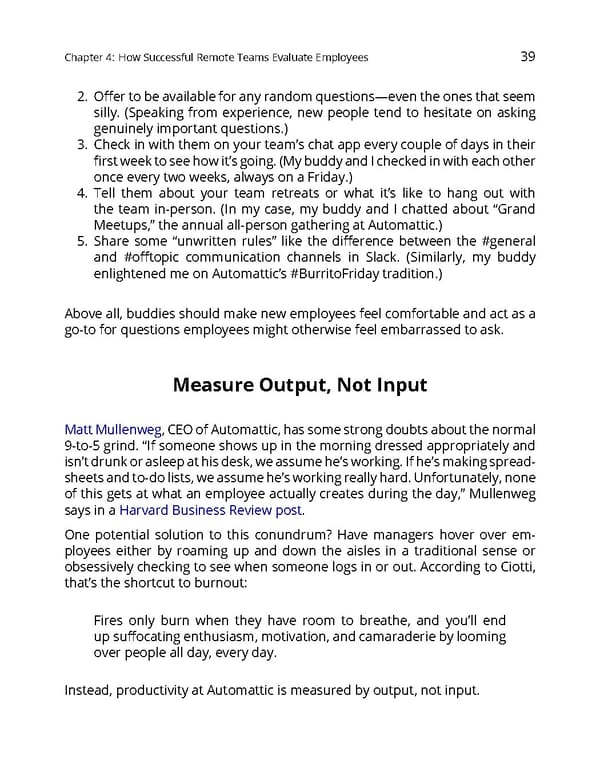Chapter4: HowSuccessfulRemoteTeamsEvaluateEmployees 39 2. Offertobeavailableforanyrandomquestions—eventheonesthatseem silly. (Speaking from experience, new people tend to hesitate on asking genuinely important questions.) 3. Check in with them on your team’s chat app every couple of days in their first weektoseehowit’sgoing.(MybuddyandIcheckedinwitheachother onceeverytwoweeks,alwaysonaFriday.) 4. Tell them about your team retreats or what it’s like to hang out with the team in-person. (In my case, my buddy and I chatted about “Grand Meetups,”theannualall-persongatheringatAutomattic.) 5. Share some “unwritten rules” like the difference between the #general and #offtopic communication channels in Slack. (Similarly, my buddy enlightened meonAutomattic’s#BurritoFridaytradition.) Aboveall, buddies should make new employees feel comfortable and act as a go-to for questions employees might otherwise feel embarrassed to ask. MeasureOutput,NotInput MattMullenweg,CEOofAutomattic,hassomestrongdoubtsaboutthenormal 9-to-5 grind. “If someone shows up in the morning dressed appropriately and isn’tdrunkorasleepathisdesk,weassumehe’sworking.Ifhe’smakingspread- sheetsandto-dolists,weassumehe’sworkingreallyhard.Unfortunately,none of this gets at what an employee actually creates during the day,” Mullenweg says in a Harvard Business Review post. One potential solution to this conundrum? Have managers hover over em- ployees either by roaming up and down the aisles in a traditional sense or obsessively checking to see when someone logs in or out. According to Ciotti, that’s the shortcut to burnout: Fires only burn when they have room to breathe, and you’ll end upsuffocatingenthusiasm,motivation,andcamaraderiebylooming overpeopleallday,everyday. Instead, productivity at Automattic is measured by output, not input.
 The Ultimate Guide to Remote Work Page 42 Page 44
The Ultimate Guide to Remote Work Page 42 Page 44